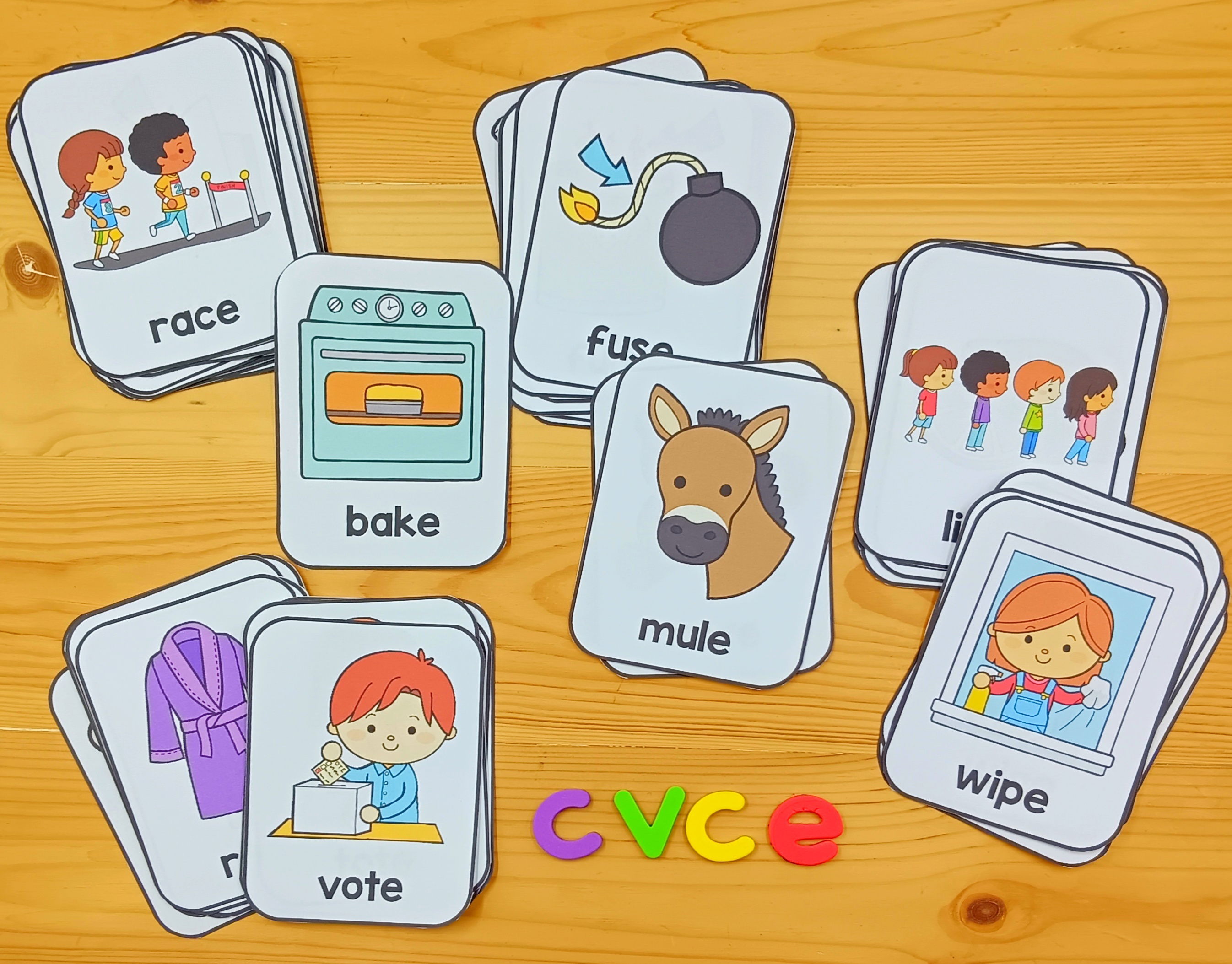How to Teach CVCE Sounds: Unleashing the Magic of the Silent E
Welcome, teachers and parents, to the magical world of CVCE sounds! If you're looking to transform your child's or students' reading journey into a spellbinding adventure, you're in the right place. This blog will explore the wonders of the CVCE sounds (also known as Magic E sounds), share some fun and effective teaching tips, and delve into fantastic activities to make learning phonics an enchanting experience!
What Are CVCE Sounds?
First things first, let's break down what CVCE sounds are. CVCE stands for Consonant-Vowel-Consonant-E, where the "E" at the end of the word is silent but magically transforms the vowel sound from short to long. For example, in the word "cake," the silent E changes the short "a" sound in "cat" to a long "a" sound. These Magic E transformations can be a tricky concept for young learners to grasp, but with the right tools and a bit of fun, they'll master it in no time!
Fun Tips and Tricks for Teaching CVCE
1. Magical Storytelling Turn CVCE lessons into a storytelling session. Create a story about a magical land where the silent E character loves to change short vowel sounds into long ones. For instance, E the Magician turns "kit" into "kite" and "tap" into "tape." This narrative approach makes the learning process more engaging and memorable.

2. Interactive Games Incorporate games like CVCE Bingo or Silent E Treasure Hunt. Create cards with CVCE words and have students match them with pictures or find them hidden around the classroom. This adds an element of fun and competition, making learning feel like play.

3. Flashcard Fun Use flashcards to familiarize students with different words. Flashcards are great for quick reviews and can be used in various interactive ways. For example, you can play "Flashcard Snap" where students snap their fingers every time they see a CVCE word.

4. Art and Crafts Combine CVCE learning with art by having students draw and color pictures of CVCE words. For instance, they could draw a "snake" for the A_E sound or a "bike" for the I_E sound. This reinforces their learning through a creative outlet.

5. Rhyme Time Encourage students to come up with rhymes using CVCE words. Rhyming helps with phonemic awareness and makes the learning process more rhythmic and enjoyable.

6. Technology Integration Utilize educational apps and online games focused on phonics and CVCE sounds. Many interactive apps are designed to make phonics fun and engaging for young learners.

Exploring CVCE Activities
Let's take a closer look at the types of activities that can be used to reinforce CVCE sounds:
1. Magic A_E Activities Engage students with activities like word hunts, build and write exercises, and picture identification. These interactive tasks make learning the A_E sound fun and easy to grasp.

2. Magic I_E Activities Help students master the I_E sound through word scrambles, picture identification, and reading comprehension activities. A variety of activities ensures different learning styles are catered to.

3. Magic O_E Activities Dive into word hunts and sentence activities focusing on the O_E sound. These hands-on approaches keep students engaged and help them learn through doing.

4. Magic U_E Activities This set of activities includes picture identification and reading comprehension tasks, all designed to help students master the U_E sound.

5. CVC and CVCE Sorting Activities Help students distinguish between short and long vowel sounds with sorting activities. This visual representation helps solidify the differences between CVC and CVCE words.

6. CVCE Flashcards are a versatile tool for reviewing and reinforcing CVCE sounds. Use them for quick, interactive reviews in the classroom or at home.

Fun Ways to Reinforce CVCE Sounds
1. Magic E Puppet Show Create a puppet show where characters transform words using the Magic E. Kids can participate by holding up signs with words and showing how the silent E changes the vowel sound. This interactive approach helps reinforce the concept through visual and hands-on learning.

2. Magic E Detective Provide students with a magnifying glass and a list of CVC words. Their mission is to find objects around the classroom or home that can be transformed by adding a Magic E. For example, finding a "cap" and turning it into a "cape."

3. Spell It Out Use letter tiles or magnetic letters to build CVCE words. This tactile activity allows students to physically manipulate letters, helping them understand the structure of CVCE words better.

4. CVCE Word Wall Create a CVCE word wall in your classroom. Add new words as students learn them. This visual representation serves as a constant reminder and reference point for students, making it easier to remember words.

5. CVCE Charades Play a game of charades where students act out CVCE words. This not only reinforces their understanding but also gets them moving and using their imagination.

Conclusion: The Magic of CVCE Sounds
Teaching CVCE sounds doesn't have to be a mundane task. By incorporating fun and engaging activities, storytelling, games, and interactive lessons, you'll make learning an enjoyable experience. Keep the activities varied and exciting and watch as your students master the Magic E with enthusiasm and confidence. So, why wait? Dive into the magical world of CVCE sounds today and watch your students' reading skills soar!
Follow Me for More Teaching Tips with Joy For more tips, resources, and a daily dose of teaching joy, follow me on:
Got questions or want to share your success stories? Drop me an email at thejoyinteaching@gmail.com. I love hearing from fellow educators and parents! Happy Teaching!
Joy Medalla
The Joy in Teaching 💛